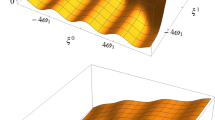Abstract
We consider an open string with ends laying on the two different solid beams (rods). This setup is equivalent to two scalar fields with a set of constraints at their end-points. We calculate the zero-point energy and the Casimir energy in three different ways: (1) by use of the Hurwitz zeta function, (2) by employing the contour integration method in the complex frequency plane, and (3) by constructing the Green’s function for the system. In the case of contour integration we also present a finite temperature expression for the Casimir energy, along with a convenient analytic approximation for high temperatures. The Casimir energy at zero temperature is found to be a sum of the Luscher potential energy and a term depending on the angle between the beams. The relationship of this model to an analogous open string model with charges fixed at its ends, moving in an electromagnetic field, is discussed.
Similar content being viewed by others
REFERENCES
K. A. Milton, The Casimir Energy: Physical Manifestations of Zero-Point Energy (World Scientific, Singapore, 2001).
M. Luscher, K. Symanzik, and P. Weisz, Nucl. Phys. B 173, 365 (1980).
M. Luscher, Nud. Phys. B 180, 317 (1981).
O. Alvarez, Phys. Rev. D 24, 440 (1981).
L. Hadasz, G. Lambiase, and V. V. Nesterenko, Phys. Rev. D 62, 025011 (2000).
I. Brevik, A. A. Bytsenko, and B. M. Pimentel, in Theoretical Physics 2002, Ed. by T. F. George and H. F. Arnoldus (Nova Science, New York, 2003).
I. Brevik and H. B. Nielsen, Phys. Rev. D 41, 1185 (1990).
I. Brevik and E. Elizalde, Phys. Rev. D 49, 5319 (1994).
I. Brevik and H. B. Nielsen, Phys. Rev. D 51, 1869 (1995).
E. D’Hoker and P. Sikivie, Phys. Rev. Lett. 71, 1136 (1993).
E. Elizalde and S. D. Odintsov, Class. Quant. Grav. 12, 2881 (1995).
G. Lambiase and V. V. Nesterenko, Phys. Rev. D 54, 6387 (1996).
H. Kleinert, G. Lambiase, and V. V. Nesterenko, Phys. Lett. B 384, 213 (1996).
A. Jahan and S. Sukhasena, Int. J. Mod. Phys. A 33, 1850097 (2018).
R. de L. Kronig and W. G. Penney, Proc. R. Soc. London, Ser. A 130, 499 (1931).
E. Elizalde, S. D. Odintsov, A. Romeo, A. A. Bytsenko, and S. Zerbini, Zeta Regularization Techniques with Applications (World Scientific, Singapore, 1994).
E. Elizalde, Ten Physical Applications of Spectral Zeta Functions (Springer, Berlin, 1995).
X. Li, X. Shi and J. Zhang, Phys. Rev. D 44, 560 (1991).
C.-J. Feng and X.-Z. Li, Phys. Lett. B 691, 167 (2010).
Yu. S. Barash and V. L. Ginzburg, in Electromagnetic Fluctuations and Molecular Forces in Condensed Matter, Ed. by L. V. Keldysh (Elsevier, Amsterdam, 1989), Chap. 6.
N. G. van Kampen, B. R. A. Nijboer, and K. Schram, Phys. Lett. A 26, 307 (1968).
K. A. Milton, P. Kalauni, P. Parashar, and Y. Li, Phys. Rev. D 99, 045013 (2019).
J. S. Hø ye, I. Brevik and K. A. Milton, Phys. Rev. A 94, 032113 (2016).
I. S. Gradshteyn and I. M. Ryzhik, Table of Integrals, Series, and Products, 7th ed. (Academic, New York, 2007).
V. V. Nesterenko, Int. J. Mod. Phys. A 4, 2627 (1989).
ACKNOWLEDGMENTS
I. B. thanks Vladimir Nesterenko for valuable information. The same author acknowledges financial support from the Research Council of Norway, project 250346.
Author information
Authors and Affiliations
Corresponding author
APPENDIX A
APPENDIX A
To evaluate the infinite sum in the first line of (50) we write
where nr = n + r. Then by virtue of the formula
we get
Rights and permissions
About this article
Cite this article
Jahan, A., Brevik, I. Casimir Energy of an Open String with Angle-Dependent Boundary Conditions. J. Exp. Theor. Phys. 129, 831–837 (2019). https://doi.org/10.1134/S1063776119110049
Received:
Revised:
Accepted:
Published:
Issue Date:
DOI: https://doi.org/10.1134/S1063776119110049



